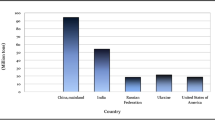Abstract
One of the challenges with using sweet sorghum as an energy crop is that although fermentation of the juice to ethanol does not require enzymes, the juice can easily spoil. One strategy to avoid spoilage is to harvest the juice in the field, place it into a tanker for transport, and add the yeast immediately to initiate the fermentation process to begin during transport. Hence, it is also important to understand how the fermentation process is influenced by pH, temperature, and dissolved oxygen, since these parameters would not be “controlled” during transport. A full factorial design was applied to examine and optimize yield efficiency of ethanol production for the fermentation of sweet sorghum juice. Bioethanol yield efficiency was modeled using a linear equation. Under optimal pH (5.5), temperature (28 °C), and dissolved oxygen (0%) conditions, a maximum theoretical yield efficiency of 0.75 was achieved for bioethanol produced from M81E variety of sweet sorghum.




Similar content being viewed by others
References
Conti JJ, Holtberg PD, Beamon JA, Schaal AM, Sweetnam GE, Kydes AS (2010) Annual energy outlook 2010: with projections to 2035. U.S. Energy Information Administration, Washington, DC
Flugge M, Lewandrowski J, Rosenfeld J, Boland C, Hendrickson T, Jaglo K, Kolansky S, Moffroid K, Riley-Gilbert M, Pape D (2017) A life-cycle analysis of the greenhouse gas emissions of corn-based ethanol. Report prepared by ICF under USDA Contract No. AG-3142-D-16-0243. January 30, 2017
Wang M, Han J, Dunn JB, Cai H, Elgowainy A (2012) Well-to-wheels energy use and greenhouse gas emissions of ethanol from corn, sugarcane and cellulosic biomass for US use. Environ Res Lett 7(4). https://doi.org/10.1088/1748-9326/7/4/045905
Mathur S, Umakanth AV, Tonapi VA, Sharma R, Sharma MK (2017) Sweet sorghum as biofuel feedstock: recent advances and available resources. Biotechnol Biofuels 10:146. https://doi.org/10.1186/s13068-017-0834-9
Alvey SBM, Neumann G, Buerkert A (2001) Cereal/legume rotations affect chemical properties and biological activities in two West African soils. Plant Soil 231:45–54
Almodares A, Mostafafi Darany SM (2006) Effects of planting date and time of nitrogen application on yield and sugar content of sweet sorghum. J Environ Biol 27(3):601–605
Wiedenfeld RP (1984) Nutrient requirements and use efficiency by sweet sorghum. Energy in Agriculture 3:49–59
Zegada-Lizarazu W, Monti A (2012) Are we ready to cultivate sweet sorghum as a bioenergy feedstock? A review on field management practices. Biomass Bioenergy 40:1–12. https://doi.org/10.1016/j.biombioe.2012.01.048
Ebrahimiaqda E, Ogden KL (2017) Simulation and cost analysis of distillation and purification step in production of anhydrous ethanol from sweet sorghum. ACS Sustain Chem Eng 5(8):6854–6862. https://doi.org/10.1021/acssuschemeng.7b01082
Kundiyana DK, Bellmer DD, Huhnke RL, Wilkins MR, Claypool PL (2010) Influence of temperature, pH and yeast on in-field production of ethanol from unsterilized sweet sorghum juice. Biomass Bioenergy 34(10):1481–1486. https://doi.org/10.1016/j.biombioe.2010.04.022
Wang w WJ, Tan JX, Sun JF, Mou JL (2011) Optimization of ethanol fermentation from sweet sorghum juice using response surface methodology. Energy Sources, Part A: Recovery, Utilization, and Environmental Effects 33:1139–1146. https://doi.org/10.1080/15567030903330801
Liu R, Shen F (2008) Impacts of main factors on bioethanol fermentation from stalk juice of sweet sorghum by immobilized Saccharomyces cerevisiae (CICC 1308). Bioresour Technol 99(4):847–854. https://doi.org/10.1016/j.biortech.2007.01.009
Weather Underground. (2017) The Weather Company, LLC. https://www.wunderground.com. 2017
Teetor VH, Duclos DV, Wittenberg ET, Younga KM, Chawhuaymakc J, Riley MR, Ray DT (2011) Effects of planting date on sugar and ethanol yield of sweet sorghum grown in Arizona. Ind Crops Prod 34:1293–1300. https://doi.org/10.1016/j.indcrop.2010.09.010
Broadhead DM, Freeman KC, Zummo N (1981) 'M 81E'—A new variety of sweet sorghum. USDA,ARS. Meridian,Miss
Teetor VH, Schmalzel C, Ray DT (2017) Growing sweet sorghum (Sorghum bicolor [L.] moench) in clumps potentially reduces lodging in the arid-southwestern United States. Ind Crops Prod 107:458–462. https://doi.org/10.1016/j.indcrop.2017.05.064
Borzani W (2006) Batch ethanol fermentation: the correlation between the fermentation efficiency and the biomass initial concentration depends on what is considered as produced ethanol. Braz J Microbiol 37:87–89
Akin H, Brandam C, Meyer X-M, Strehaiano P (2008) A model for pH determination during alcoholic fermentation of a grape must by Saccharomyces cerevisiae. Chem Eng Process Process Intensif 47(11):1986–1993. https://doi.org/10.1016/j.cep.2007.11.014
Coote N, Kirsop BH (1976) Factors responsible for the decrease in pH during beer fermentations. J Inst Brew 82:149–153
Gray KA, Zhao L, Emptage M (2006) Bioethanol. Curr Opin Chem Biol 10(2):141–146. https://doi.org/10.1016/j.cbpa.2006.02.035
Le Man H, Behera SK, Park HS (2010) Optimization of operational parameters for ethanol production from Korean food waste leachate. Int J Environ Sci Tech 7(1):157–164
Ma H, Wang Q, Zhang W, Xu W, Zou D (2008) Optimization of the medium and process parameters for ethanol production from kitchen garbage by Zymomonas mobilis. Int J Green Energy 5(6):480–490. https://doi.org/10.1080/15435070802498176
Rivera ECCA, Atala DIP, Maugeri F, Maciel MRW, Filho RM (2006) Evaluation of optimization techniques for parameter estimation: application to ethanol fermentation considering the effect of temperature. Process Biochem 41(7):1682–1687. https://doi.org/10.1016/j.procbio.2006.02.009
Le HD, Thanonkeo P, Le VV (2013) Impact of high temperature on ethanol fermentation by Kluyveromyces marxianus immobilized on banana leaf sheath pieces. Appl Biochem Biotechnol 171(3):806–816. https://doi.org/10.1007/s12010-013-0411-z
Nagodawithana TW, Castellano C, KH S (1974) Effect of dissolved oxygen, temperature, initial cell count, and sugar concentration on the viability of Saccharomyces cerevisiae in rapid fermentations. Appl Microbiol 28(3):383–391
Verbelen PJ, Depraetere SA, Winderickx J, Delvaux FR, Delvaux F (2009) The influence of yeast oxygenation prior to brewery fermentation on yeast metabolism and the oxidative stress response. FEMS Yeast Res 9(2):226–239. https://doi.org/10.1111/j.1567-1364.2008.00476.x
Funding
This work was supported by the USDA Sun Grant No.09W-T020.
Author information
Authors and Affiliations
Corresponding author
Rights and permissions
About this article
Cite this article
Ebrahimiaqda, E., Ogden, K.L. Evaluation and Modeling of Bioethanol Yield Efficiency from Sweet Sorghum Juice. Bioenerg. Res. 11, 449–455 (2018). https://doi.org/10.1007/s12155-018-9909-0
Published:
Issue Date:
DOI: https://doi.org/10.1007/s12155-018-9909-0




